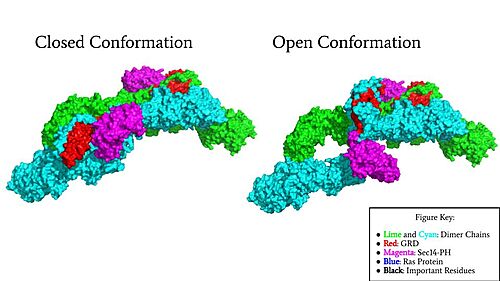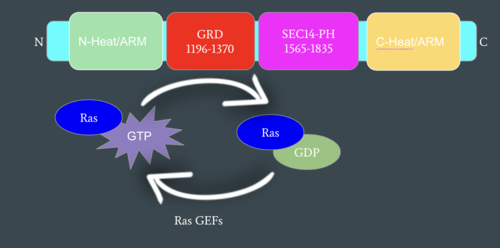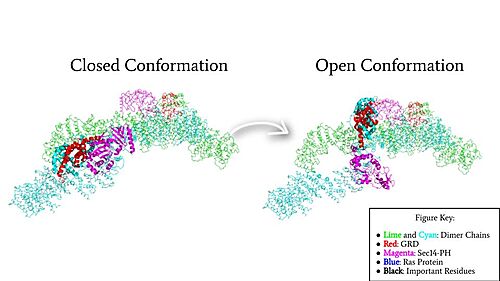Sandbox Reserved 1710
From Proteopedia
(Difference between revisions)
| Line 6: | Line 6: | ||
== Introduction == | == Introduction == | ||
[[Image:Neurofibromin Surface w Labels.jpg|500 px|right|thumb|Figure 1: Surface Rendering of Neurofibromin in its Open (7PGT) and Closed (7PGR) Conformation.]] | [[Image:Neurofibromin Surface w Labels.jpg|500 px|right|thumb|Figure 1: Surface Rendering of Neurofibromin in its Open (7PGT) and Closed (7PGR) Conformation.]] | ||
| - | Neurofibromin functions as a tumor suppressor protein by associating with [https://proteopedia.org/wiki/index.php/Ras Ras], a protein that signals for [https://en.wikipedia.org/wiki/Cell_proliferation cell proliferation] and growth. It has two conformations, the open, active conformation and the closed, inactive conformation (Figure 1). <ref name="Trovó-Marqui">PMID:16813595</ref> The change in conformation of Neurofibromin from open to closed regulates Ras activity, turning it off, thus stopping cell growth from continuing in excess. Neurofibromin is a [https://en.wikipedia.org/wiki/Dimer_(chemistry) dimer] made up of two identical [https://en.wikipedia.org/wiki/Monomer monomers] consisting of the Sec 14-PH domain and the GRD (Gap-related domain). The orientation of these domains is important for the interaction and binding of Ras to the Arginine finger in Neurofibromin, a key interaction in the regulation of Ras activity. Neurofibromin in its open conformation allows for the Ras association, unlike the closed conformation which is unable to associate with Ras and turn it off. <ref name="Naschberger">PMID:34707296</ref> The closed conformation is stabilized by a triad consisting of | + | Neurofibromin functions as a tumor suppressor protein by associating with [https://proteopedia.org/wiki/index.php/Ras Ras], a protein that signals for [https://en.wikipedia.org/wiki/Cell_proliferation cell proliferation] and growth. It has two conformations, the open, active conformation and the closed, inactive conformation (Figure 1). <ref name="Trovó-Marqui">PMID:16813595</ref> The change in conformation of Neurofibromin from open to closed regulates Ras activity, turning it off, thus stopping cell growth from continuing in excess. Neurofibromin is a [https://en.wikipedia.org/wiki/Dimer_(chemistry) dimer] made up of two identical [https://en.wikipedia.org/wiki/Monomer monomers] consisting of the Sec 14-PH domain and the GRD (Gap-related domain). The orientation of these domains is important for the interaction and binding of Ras to the Arginine finger in Neurofibromin, a key interaction in the regulation of Ras activity. Neurofibromin in its open conformation allows for the Ras association, unlike the closed conformation which is unable to associate with Ras and turn it off. <ref name="Naschberger">PMID:34707296</ref> The closed conformation is stabilized by a triad consisting of Cys1032, His1558, and His1576 and a Zinc atom. The molecular structure and detail of Neurofibromin have been determined by [https://en.wikipedia.org/wiki/Cryogenic_electron_microscopy Cryo-Electron Microscopy]. Additionally, the structure of Neurofibromin isoform 2 revealed different functional states for Neurofibromin. <ref name="Naschberger">PMID:34707296</ref> Neurofibromin is encoded by the [https://en.wikipedia.org/wiki/Neurofibromin_1 NF1 gene], which is located on chromosome 17. Mutations in the NF1 gene are associated with diseases including Neurofibromatosis Type 1, [https://en.wikipedia.org/wiki/Neurofibroma Plexiform Neurofibromas], and cancers including glioblastoma, neuroblastoma, lung, ovarian, and breast cancer. <ref name="Lupton">PMID: 34887559 </ref> <ref name="Ratner">PMID:25877329</ref> <ref name="Abramowicz">PMID:25182393</ref> |
== Function == | == Function == | ||
[[Image:mechanismofRas.png|500 px|left|thumb|Figure 2: Mechanism of Ras Regulation by Neurofibromin. One chain of the homodimer is represented in cyan with its important domains highlighted. Ras Guanine Nucleotide Exchange Factors (RasGEFs) are shown catalyzing the transition from an active to an inactive Ras molecule and Neurofibromin is shown catalyzing the reverse reaction]] | [[Image:mechanismofRas.png|500 px|left|thumb|Figure 2: Mechanism of Ras Regulation by Neurofibromin. One chain of the homodimer is represented in cyan with its important domains highlighted. Ras Guanine Nucleotide Exchange Factors (RasGEFs) are shown catalyzing the transition from an active to an inactive Ras molecule and Neurofibromin is shown catalyzing the reverse reaction]] | ||
| - | Neurofibromin functions as a tumor suppressor protein.<ref name="Trovó-Marqui">PMID:16813595</ref> It prevents cell growth by turning off [https://en.wikipedia.org/wiki/Ras_GTPase Ras] which in its active state, stimulates cell growth and division (Figure 2). Ras is a small, monomeric [https://en.wikipedia.org/wiki/GTPase GTPase] that binds to [https://en.wikipedia.org/wiki/Guanosine_triphosphate GTP] and hydrolyzes it to [https://en.wikipedia.org/wiki/Guanosine_diphosphate GDP]. When Ras is active, it subsequently activates other proteins that stimulate cell growth and proliferation. Ras is membrane-bound and interacts with Neurofibromin, a cytoplasmic protein, in the open conformation of Neurofibromin. Neurofibromin is brought to the membrane to associate with Ras by [https://en.wikipedia.org/wiki/SPRED1 SPRED1]. [https://medlineplus.gov/genetics/gene/spred1/ SPRED1] is a protein that helps regulate the [https://en.wikipedia.org/wiki/MAPK/ERK_pathway Ras/MAPK signaling pathway] responsible for the growth and proliferation of cells. Binding of SPRED1 to [https://en.wikipedia.org/wiki/RAF_kinase Raf] in the MAPK signaling pathway blocks the activation of Raf, halts the rest of the pathway, and stops cell growth and proliferation. Unlike Ras, Neurofibromin can interact with SPRED1 in both the open and closed conformations.<ref name="Naschberger">PMID:34707296</ref> The interaction between Neurofibromin and Ras is activated via an [https://en.wikipedia.org/wiki/Arginine_finger Arginine finger] ( | + | Neurofibromin functions as a tumor suppressor protein.<ref name="Trovó-Marqui">PMID:16813595</ref> It prevents cell growth by turning off [https://en.wikipedia.org/wiki/Ras_GTPase Ras] which in its active state, stimulates cell growth and division (Figure 2). Ras is a small, monomeric [https://en.wikipedia.org/wiki/GTPase GTPase] that binds to [https://en.wikipedia.org/wiki/Guanosine_triphosphate GTP] and hydrolyzes it to [https://en.wikipedia.org/wiki/Guanosine_diphosphate GDP]. When Ras is active, it subsequently activates other proteins that stimulate cell growth and proliferation. Ras is membrane-bound and interacts with Neurofibromin, a cytoplasmic protein, in the open conformation of Neurofibromin. Neurofibromin is brought to the membrane to associate with Ras by [https://en.wikipedia.org/wiki/SPRED1 SPRED1]. [https://medlineplus.gov/genetics/gene/spred1/ SPRED1] is a protein that helps regulate the [https://en.wikipedia.org/wiki/MAPK/ERK_pathway Ras/MAPK signaling pathway] responsible for the growth and proliferation of cells. Binding of SPRED1 to [https://en.wikipedia.org/wiki/RAF_kinase Raf] in the MAPK signaling pathway blocks the activation of Raf, halts the rest of the pathway, and stops cell growth and proliferation. Unlike Ras, Neurofibromin can interact with SPRED1 in both the open and closed conformations.<ref name="Naschberger">PMID:34707296</ref> The interaction between Neurofibromin and Ras is activated via an [https://en.wikipedia.org/wiki/Arginine_finger Arginine finger] (Arg1276) present in the GRD domain of Neurofibromin. Arg1276 is only accessible for binding when the GRD and Sec14-PH domains are rotated into the open conformation. Ras binds to the arginine finger of Neurofibromin with its switch regions 1 and 2.<ref name="Trovó-Marqui">PMID:16813595</ref When Arg1276 is able to associate with Ras, Neurofibromin downregulates the [https://en.wikipedia.org/wiki/MAPK/ERK_pathway Ras signaling pathway] by speeding up Ras's GTPase activity, hydrolyzing the GTP associated with Ras to GDP. In its GDP bound state, Ras is inactive and cell growth and division is inhibited. <ref name="Naschberger">PMID:34707296</ref> |
| Line 20: | Line 20: | ||
=== Closed Conformation === | === Closed Conformation === | ||
| - | In the <scene name='90/904315/Closed/3'>closed, inactive conformation</scene>, the GRD and Sec14-PH domains are rotated so Ras cannot bind. In this conformation, the GRD and Sec14-PH are inaccessible and inactive. Neurofibromin is held in the inactive state by a <scene name='90/904315/Closed_triade/7'>triad</scene> consisting of residues | + | In the <scene name='90/904315/Closed/3'>closed, inactive conformation</scene>, the GRD and Sec14-PH domains are rotated so Ras cannot bind. In this conformation, the GRD and Sec14-PH are inaccessible and inactive. Neurofibromin is held in the inactive state by a <scene name='90/904315/Closed_triade/7'>triad</scene> consisting of residues Cys1032, His1558, and His1576 that form a transition metal-binding site with zinc. The rigid organization of the <scene name='90/904315/Closed_triade/8'>triad in closed conformation</scene> keeps the GRD domain packed tightly on top of the Heat Arms in the Neurofibromin core. This tight compaction sterically occludes Neurofibromin from <scene name='90/904315/Closed_with_ras/2'>associating with Ras.</scene> In its active form, Ras and Neurofibromin will associate via an <scene name='90/904315/Arg_finger/5'>Arginine Finger</scene>(Arg1276). However, the <scene name='90/904315/Arg_finger/3'>steric hindrance</scene> from the Neurofibromin core in the closed conformation inhibits this association. Therefore, in the closed conformation, neurofibromin cannot catalyze GTP hydrolysis by Ras and Ras continues to signal for cell growth and proliferation.<ref name="Naschberger">PMID:34707296</ref> |
=== Open Conformation === | === Open Conformation === | ||
| - | In the <scene name='90/904315/Open_conformation/4'>open, active conformation</scene>, the GRD and Sec14-PH domain on one protomer have [https://youtu.be/I1I4uTVFR00 rotated] and become accessible for binding to Ras. This transition is initiated by the movement of the transition metal-binding site. The | + | In the <scene name='90/904315/Open_conformation/4'>open, active conformation</scene>, the GRD and Sec14-PH domain on one protomer have [https://youtu.be/I1I4uTVFR00 rotated] and become accessible for binding to Ras. This transition is initiated by the movement of the transition metal-binding site. The Cys1032, His1558, and His1576 Residues become separated and zinc is not able to bond. In the active form, one protomer has its GRD and Sec14-PH domains oriented oppositely from the inactive form (Figure 4). The GRD rotates -130° and the Sec14-PH domain rotates -90° away from the N-HEAT/ARM. Due to this rotation, Cys1032 is now located too far away, approximately 30 Å, from His1558 and His1576 which results in the loss of the metal-binding site and no formation of the <scene name='90/904315/Open_conformation_triade/6'>triad</scene>. The lack of the transition metal-binding site allows the GRD to orient itself to <scene name='90/904315/Openwithras/1'>associate with Ras</scene><ref name="Naschberger">PMID:34707296</ref>. This association positions the <scene name='90/904315/Open_conformation_arginine_fin/3'>Arginine Finger</scene> to help stabilize and orient a catalytic Ras residue (Q61) so that the gamma phosphate of GTP can be nucleophilically attacked <ref>PMID:33121128</ref>. When Neurofibromin is in the open, active conformation, <scene name='90/904315/Open_conformation_arginine_fin/4'>Arg1276</scene> is able to bind to Ras because there is no steric hindrance from the Neurofibromin core.<ref name="Naschberger">PMID:34707296</ref> |
[[Image:Domain Rotation.jpg|500 px|left|thumb|Figure 4: Rotation of the GRD and Sec14-PH domains from the closed conformation (7PGR) of neurofibromin to the open conformation (7PGT) of neurofibromin to allow Ras binding. The GRD rotates -130° and the Sec14-PH domain rotates -90°]] | [[Image:Domain Rotation.jpg|500 px|left|thumb|Figure 4: Rotation of the GRD and Sec14-PH domains from the closed conformation (7PGR) of neurofibromin to the open conformation (7PGT) of neurofibromin to allow Ras binding. The GRD rotates -130° and the Sec14-PH domain rotates -90°]] | ||
Revision as of 02:25, 19 April 2022
| This Sandbox is Reserved from February 28 through September 1, 2022 for use in the course CH462 Biochemistry II taught by R. Jeremy Johnson at the Butler University, Indianapolis, USA. This reservation includes Sandbox Reserved 1700 through Sandbox Reserved 1729. |
To get started:
More help: Help:Editing |
Human Neurofibromin - The Tumor Suppressor Gene
| |||||||||||
References
- ↑ 1.0 1.1 1.2 Trovo-Marqui AB, Tajara EH. Neurofibromin: a general outlook. Clin Genet. 2006 Jul;70(1):1-13. doi: 10.1111/j.1399-0004.2006.00639.x. PMID:16813595 doi:http://dx.doi.org/10.1111/j.1399-0004.2006.00639.x
- ↑ 2.0 2.1 2.2 2.3 2.4 2.5 2.6 Naschberger A, Baradaran R, Rupp B, Carroni M. The structure of neurofibromin isoform 2 reveals different functional states. Nature. 2021 Nov;599(7884):315-319. doi: 10.1038/s41586-021-04024-x. Epub 2021, Oct 27. PMID:34707296 doi:http://dx.doi.org/10.1038/s41586-021-04024-x
- ↑ 3.0 3.1 Lupton CJ, Bayly-Jones C, D'Andrea L, Huang C, Schittenhelm RB, Venugopal H, Whisstock JC, Halls ML, Ellisdon AM. The cryo-EM structure of the human neurofibromin dimer reveals the molecular basis for neurofibromatosis type 1. Nat Struct Mol Biol. 2021 Dec;28(12):982-988. doi: 10.1038/s41594-021-00687-2., Epub 2021 Dec 9. PMID:34887559 doi:http://dx.doi.org/10.1038/s41594-021-00687-2
- ↑ 4.0 4.1 4.2 Ratner N, Miller SJ. A RASopathy gene commonly mutated in cancer: the neurofibromatosis type 1 tumour suppressor. Nat Rev Cancer. 2015 May;15(5):290-301. doi: 10.1038/nrc3911. Epub 2015 Apr 16. PMID:25877329 doi:http://dx.doi.org/10.1038/nrc3911
- ↑ 5.0 5.1 5.2 Abramowicz A, Gos M. Neurofibromin in neurofibromatosis type 1 - mutations in NF1gene as a cause of disease. Dev Period Med. 2014 Jul-Sep;18(3):297-306. PMID:25182393
- ↑ Bergoug M, Doudeau M, Godin F, Mosrin C, Vallee B, Benedetti H. Neurofibromin Structure, Functions and Regulation. Cells. 2020 Oct 27;9(11). pii: cells9112365. doi: 10.3390/cells9112365. PMID:33121128 doi:http://dx.doi.org/10.3390/cells9112365




